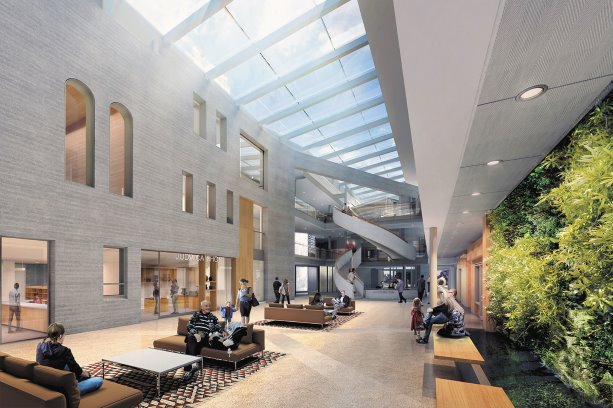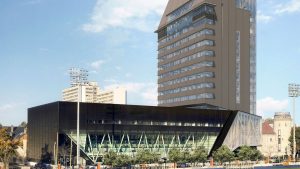Toronto’s Holy Blossom Temple, the city’s oldest Jewish congregation, is undertaking an ambitious, multi-phased renewal project at its campus on Bathurst Street.
Phase 1 of the project includes major mechanical and electrical system upgrades, new construction and renovation of existing spaces — including major public spaces.
Enabling works to facilitate the continued occupancy of the facility during construction have been ongoing during the past year, since the project got a green light.
Martin Davidson, principal in charge of the project at Diamond Schmitt Architects, said construction documents are currently being completed for the first phase.
He said general contractors will be prequalified to bid on the project. That process will be undertaken by Diamond Schmitt in consultation with the temple leadership.
"We anticipate a 14-month to 16-month construction schedule," Davidson said.
Infrastructure upgrades are scheduled to be completed in Phase 2, as well as renovations to the temple’s sanctuary and the remainder of the site works.
A start date has not been established.
The project is being undertaken by a team that includes structural engineers Blackwell, mechanical engineers Smith + Andersen, electrical engineers Mulvey & Banani International Inc. and landscape architects DTAH.
Construction cost estimates have not been released for the renewal project.
Davidson, who has expertise in both historic renovation and new construction and who has worked on such projects as the Jewish Community Center in Manhattan, said there are two prime drivers for the Holy Blossom renewal project — one architectural and the other technical.
"As the building evolved over the years, and major additions were undertaken, the circulation became extremely convoluted," he said. "The ability for the congregation to meet together outside of the main sanctuary was limited."
At the same time, Davidson said, cultural and religious patterns of use have changed since the temple, the original building, opened in 1938. A school wing was added in 1960.
"Our goal was to reorganize and clarify circulation patterns and create a new ‘living room’ for the congregation by the introduction of a central atrium that organizes the main programmatic elements of the building around a central gathering space."
At the same time, Davidson said, the project "is really about bringing architectural expression to the temple’s desire for renewal, not just organizationally but in terms of re-engaging a new generation of members.
"We’ve tried to do this by introducing a more open and transparent feel to the synagogue by creating spaces that are more casual and inviting and by introducing program spaces that are flexible and can extend the temple’s engagement with the wider community."
Technically, Davidson said, the temple’s building systems were well beyond their anticipated life span. Consequently, the building is in need of a complete upgrade.
"The congregation is aware of its opportunity to show its environmental stewardship," he said.
"As part of this upgrade, we are pursuing LEED certification."
The temple was designed in the Romanesque revival style.
The 1960 wing, designed by John B. Parkin Associates, houses a youth chapel, congregational hall and pre-school.
From a design and construction perspective, Davidson said renovation projects "always pose challenges and this project is no different.
"We are working within both the 1938 and 1960 buildings that have very different construction systems, technical systems and quality and type of spaces," he said.
"Inserting new interventions that respect both the existing architectural language yet introduce a modern sensibility and expression is always a delicate balance."
The temple was founded in 1856. Its first synagogue was built downtown on Richmond Street 20 years later. By the 1890s, the congregation had outgrown those premises. A new synagogue, which was dedicated in 1897, was constructed on Bond Street. The temple subsequently relocated to Bathurst Street in north Toronto in the 1930s.





Recent Comments
comments for this post are closed